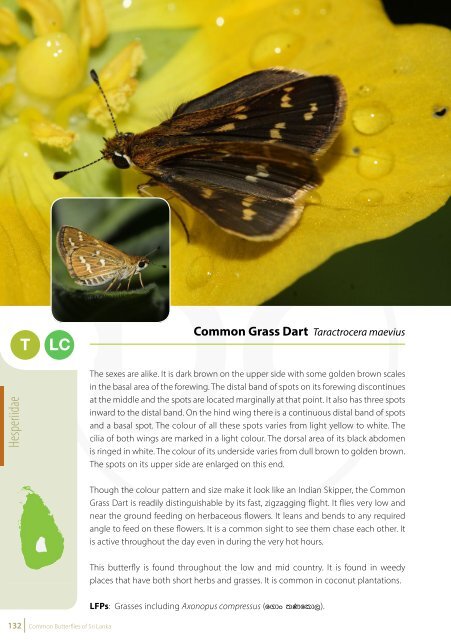Common Butterflies of Sri Lanka
Common Butterflies of Sri Lanka
Common Butterflies of Sri Lanka
You also want an ePaper? Increase the reach of your titles
YUMPU automatically turns print PDFs into web optimized ePapers that Google loves.
<strong>Common</strong> Grass Dart Taractrocera maevius<br />
Dark Palm Dart Telicota bambusae<br />
T LC S VU<br />
Hesperiidae<br />
The sexes are alike. It is dark brown on the upper side with some golden brown scales<br />
in the basal area <strong>of</strong> the forewing. The distal band <strong>of</strong> spots on its forewing discontinues<br />
at the middle and the spots are located marginally at that point. It also has three spots<br />
inward to the distal band. On the hind wing there is a continuous distal band <strong>of</strong> spots<br />
and a basal spot. The colour <strong>of</strong> all these spots varies from light yellow to white. The<br />
cilia <strong>of</strong> both wings are marked in a light colour. The dorsal area <strong>of</strong> its black abdomen<br />
is ringed in white. The colour <strong>of</strong> its underside varies from dull brown to golden brown.<br />
The spots on its upper side are enlarged on this end.<br />
Though the colour pattern and size make it look like an Indian Skipper, the <strong>Common</strong><br />
Grass Dart is readily distinguishable by its fast, zigzagging flight. It flies very low and<br />
near the ground feeding on herbaceous flowers. It leans and bends to any required<br />
angle to feed on these flowers. It is a common sight to see them chase each other. It<br />
is active throughout the day even in during the very hot hours.<br />
This butterfly is found throughout the low and mid country. It is found in weedy<br />
places that have both short herbs and grasses. It is common in coconut plantations.<br />
LFPs: Grasses including Axonopus compressus (f.dx ;Kfld,).<br />
It is usually smaller than the Yellow Palm Dart. The background <strong>of</strong> its upper side is<br />
dark brown in colour. Its orange coloured distal band and the band along the upper<br />
margin merge near the apex <strong>of</strong> the forewing. The sex brand is marked in a lighter<br />
colour in the space in between these bands in males. The orange colour <strong>of</strong> this distal<br />
band does not continue along the veins towards the outer margin as in other Palm<br />
Darts. The hind wing has a broad orange coloured distal band and another patch near<br />
its base. The cilia are orange in both wings. The underside is yellowish orange and it<br />
resembles that <strong>of</strong> other Palm Darts. The orange coloured patches on the upper side<br />
are slightly obvious here and have some black scales at their margins.<br />
The fast-flying Dark Palm Dart prefers to fly at scrub level and feeds on nectar and is<br />
active throughout the day.<br />
<strong>Common</strong> in wayside vegetation and other open habitats, it is also found in bamboo<br />
forests. It extends its range to the mid hills in the southern slope and to the<br />
intermediate zone.<br />
LFPs: Bambusa multiplex (a common ornamental plant in home gardens). Its native<br />
larval food plants are Ochlandra stridula (ng) and Bambusa vulgaris (WK).<br />
Male<br />
Hesperiidae<br />
132 <strong>Common</strong> <strong>Butterflies</strong> <strong>of</strong> <strong>Sri</strong> <strong>Lanka</strong><br />
<strong>Common</strong> <strong>Butterflies</strong> <strong>of</strong> <strong>Sri</strong> <strong>Lanka</strong> 133















